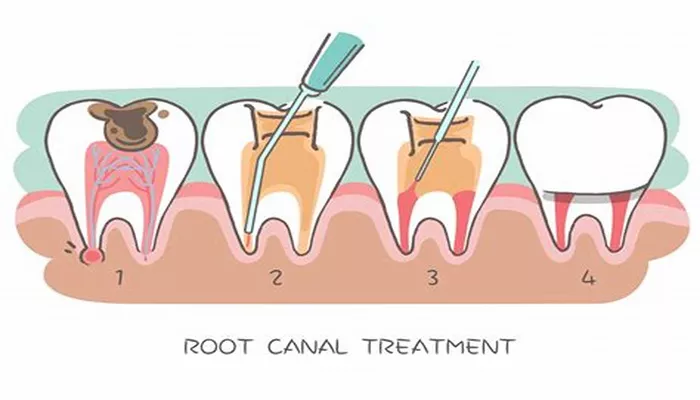A front tooth root canal is a dental procedure designed to treat infection or damage in the pulp of a front tooth. This procedure is often necessary when the tooth is cracked, has deep decay, or has suffered trauma. The front teeth include incisors and canines, which have one root, making the root canal procedure less complex than with molars.
The goal of a root canal is to clean out infected tissue, disinfect the inner chamber, and seal the tooth to prevent future infections. This allows the patient to keep the natural tooth while eliminating pain and restoring function.
Why Is a Root Canal Needed on a Front Tooth?
Several factors can lead to the need for a root canal on a front tooth:
- Deep decay that reaches the pulp
- Repeated dental procedures
- Cracked or chipped teeth from trauma
- Severe gum inflammation spreading to the pulp
Front teeth are more exposed to injury due to their location. While less likely to decay than molars, they are more prone to trauma-related damage.
How Long Does a Front Tooth Root Canal Last?
With proper care, a front tooth root canal can last between 10 and 20 years or even a lifetime. However, its longevity depends on various factors, including:
- Quality of the root canal procedure
- Follow-up restoration (usually a filling or crown)
- Oral hygiene habits
- Presence of gum disease or inflammation
Front teeth generally endure less biting pressure than back teeth, which contributes to a longer lifespan after root canal treatment.
Signs a Root Canal May Be Failing
While root canals are usually successful, some may fail due to reinfection or damage. Watch for these signs:
- Persistent pain
- Sensitivity to touch or temperature
- Swelling or gum inflammation near the treated tooth
- Bad breath or a bad taste in the mouth
- Discoloration or pus discharge
Common Complications After Root Canal
Although rare, complications can affect the longevity of a front tooth root canal:
1. Incomplete Cleaning of Canals
If any infected tissue remains inside the canal, it may lead to reinfection. This is often due to complex or narrow canals that are hard to clean thoroughly.
2. Cracked Root or Tooth
A crack that extends to the root can cause the treatment to fail. Sometimes, these cracks are invisible during the initial procedure.
3. Poor Sealing or Restoration
A temporary or poor-quality filling can allow bacteria to re-enter, causing another infection. The tooth should always be sealed properly after treatment.
4. Gum Inflammation
Untreated gum disease can compromise the stability of the treated tooth. Inflammation of the gums can cause the surrounding bone to deteriorate, leading to tooth mobility and possible failure of the root canal.
How to Maximize the Lifespan of a Root Canal
Maintain Good Oral Hygiene
Brush twice daily and floss once a day. Use fluoride toothpaste and consider antibacterial mouthwash to reduce plaque buildup and bacteria.
Regular Dental Checkups
Visit your dentist at least twice a year to monitor the treated tooth and catch early signs of gum inflammation or decay.
Protect Your Teeth
Wear a mouthguard if you grind your teeth or play contact sports. Avoid biting hard objects like ice, pens, or fingernails, as these can damage the tooth.
Treat Gum Inflammation Promptly
If you notice bleeding gums, swelling, or bad breath, see a dentist immediately. Early treatment of gum issues can prevent them from affecting your root-canaled tooth.
Managing Bad Breath After a Root Canal
Bad breath after a root canal could indicate infection or poor oral hygiene. Ensure you:
- Rinse with antimicrobial mouthwash
- Clean between teeth with interdental brushes or floss
- Brush the tongue, where odor-causing bacteria accumulate
- Have your dentist evaluate persistent odor or discomfort
Is a Crown Needed After a Front Tooth Root Canal?
Unlike molars, front teeth often don’t require a crown after a root canal unless they are structurally compromised. A tooth-colored filling is usually sufficient. However, if the tooth is discolored or weakened, a crown or veneer may be recommended for strength and appearance.
Does a Front Tooth Root Canal Hurt?
Thanks to modern anesthesia, the procedure itself is usually painless. Some discomfort may occur afterward, including mild swelling or tenderness, but it typically resolves within a few days. Severe pain may indicate complications and should be checked immediately.
What to Expect After the Procedure
1. Short-Term Recovery
You may experience mild discomfort for 1–3 days. Over-the-counter pain relievers and soft foods help during this period.
2. Long-Term Care
A permanent restoration is needed to protect the tooth. Follow your dentist’s advice on follow-up visits and avoid habits that stress the tooth.
How Root Canal Success Rates Differ in Front Teeth
Root canals on front teeth have a higher success rate (above 90%) compared to molars. This is because front teeth typically have one straight canal, making the procedure simpler and more predictable.
Alternative Treatments If a Root Canal Fails
If a front tooth root canal fails, treatment options include:
Retreatment: The canal is reopened, cleaned again, and sealed properly.
Apicoectomy: Surgical removal of the root tip if the infection persists.
Tooth extraction and implant: A last resort when the tooth cannot be saved.
Cost and Insurance Considerations
Root canals on front teeth are typically less expensive than molars due to the simpler anatomy. Costs range from $300 to $1,200 in the U.S., depending on the provider and region. Most dental insurance plans cover root canals, especially when medically necessary.
Conclusion
Front tooth root canals are highly successful and can last decades if well-maintained. With fewer complications and easier access than molars, front teeth are ideal candidates for long-lasting root canal therapy. Avoid gum inflammation, maintain oral hygiene, and address bad breath early to protect your restored tooth. Regular dental visits remain essential for monitoring and care.

